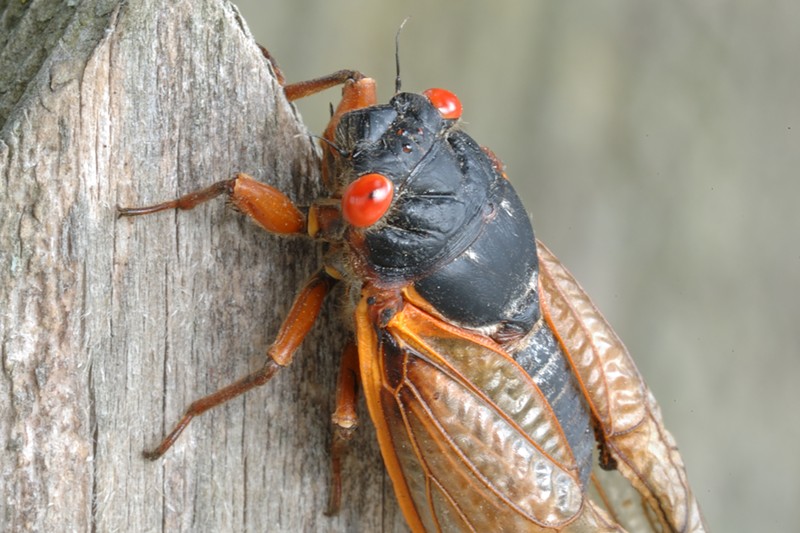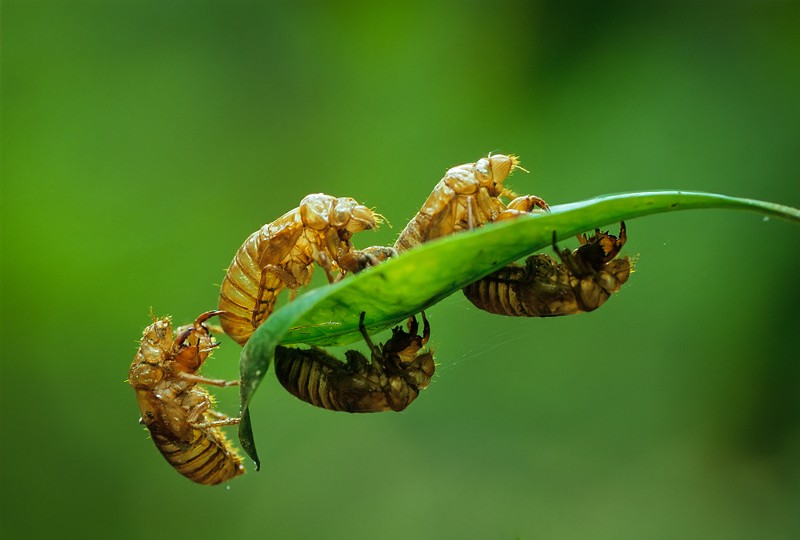
University of Michigan professor emeritus Thomas Moore has been looking forward to this season for a long time — 17 years, to be precise.
That's because this month, hordes of cicadas known as "Brood X" are expected to emerge at the end of their 17-year underground life cycle. Of the numerous broods of cicadas throughout the United States that emerge at periodic intervals, Brood X (named after the Roman numeral for 10) is among the largest, spanning from New York in the east and Illinois in the west, and as far south as Georgia and as far north as Southeastern Michigan. The insects make up the genus Magicicada, and are distinguishable by their black exoskeletons and red eyes. We last saw them in 2004.
As the temperature warms, the insects will crawl out of the ground — first a few, and then, eventually, billions — and climb up trees, where they'll shed their nymph-stage exoskeleton, leaving it behind. Then, the males will begin their unmistakable cacophonous mating call by vibrating abdominal drums called timbals.
"It starts out small and it ends up small," Moore says. But for several weeks, "They're loud. And abundant," he adds.
Moore says this will be his 48th or 49th cicada emergence he's witnessed. (Different types of cicadas have different life cycles; some have a 13-year cycle.) It will also likely be his last. Moore is 91 years old this year, and can't drive across the countryside like he used to in search of them. When he was younger and his hearing was better, he says he could tell the species apart by their songs, and was even able to estimate the number of cicadas and what stage of their mating cycle they were in.
Underground, the creatures start off the size of ants, sucking juice from plant roots. They shed their exoskeleton four times before growing to about an inch in size.
Moore says he has seen signs of some early bugs — holes in the ground about the size of a finger, and mounds of dirt called turrets. But the early emergers have probably been eaten by other animals, he says.
In fact, Moore says he's tasted cicadas a few times during his many years of studying them.
"I've eaten them raw, I've eaten them fried. I think they're better fried than raw," he says. "It's not one of my favorite foods. It's just, everything else eats them, and I figured that, what the heck, I should try them, too."
The mating season will last from two to three weeks or so. "They're still feeding on plant juices, woody plants, like trees and shrubs, and mating, and laying eggs," he says. The eggs are laid in tree branches. "The eggs hatch within a week, or two, or three, and the hatchlings fall to the ground and burrow in and stay there for 17 years eating on roots," he says.
Then, the cycle repeats. The next generation of Brood X should emerge in 2038.
Moore says the insects' unusual lifecycle offers protection from predators. "It comes out in an unpredictable number of years, and longer than most other animals can wait or anticipate," he says. "It works."
Moore says it takes patience to study such creatures. And "a good institution behind you, too," he says, referring to U-M's Department of Ecology and Evolutionary Biology and Museum of Zoology. Moore's work, along with former U-M biologist Richard Alexander, led to the publication of a 1962 monograph titled "The Evolutionary Relationships of 17-Year and 13-Year Cicadas, and Three New Species."
"It's still kind of the official documentation of what's going on," he says, humbly.
Moore says he's hoping he'll be able to see and hear Brood X this year from his Ann Arbor backyard.
"It's kind of catch-as-catch-can," he says. "It's nature, you know, and nature only does what nature wants to do." —Lee DeVito

How you can watch Brood X
Cicada basics

What is a cicada?
According to Merriam-Webster, they are “any of a family (Cicadidae) of homopterous insects which have a stout body, wide blunt head, and large transparent wings and the males of which produce a loud buzzing noise usually by stridulation.” Basically, they’re those loud black insects with transparent orange wings and red eyeballs that pop out of the ground every 17 years.
Cicadas emerge as little teenagers (nymphs), shed their exoskeletons (the creepy brown cicada-shaped shells you see on plants and in the dirt), and then eat, mate, and lay eggs in trees. Once the eggs hatch, they fall to the ground and the baby cicadas bury themselves in the earth to feed on roots until they emerge from the depths in 17 years and do it all over again.
When will they be here?
Cicadas start to burrow out of the ground when “the soil 8 inches beneath the ground reaches 64 degrees Fahrenheit,” says cicadamania.com. That means May and June, most likely, depending on the weather.
What do they eat?
Cicadas don’t actually eat. They suck up juice, aka xylem, from plants (remember phloem and xylem from biology class?), which is where the nutrients are.
Do cicadas bite?
Cicadas aren’t dangerous to humans, but they are loud and annoying. Pest control company Orkin says, “Adult cicadas do not bite humans unless they are allowed to remain on someone long enough to mistake a part of the human body for a part of a plant.” So avoid mimicking a plant while the cicadas are here.
Why are they so loud?
That blaring chirping motor sound they make? That’s the males’ song. Male cicadas vibrate their “timbals” — little membranes — to attract mates, but they also hum when they’re afraid, establishing territory or when they’ve found a girlfriend. Multiple males will sing all at once in a “chorus” to attract more females.
Can you deter them?
You cannot stop cicadas from emerging. They are inevitable.
Gene Kritsky, Ph.D., calls it a "generational event" for many residents in the area.
"For people who have been around awhile, they will remember what it was like 17 years ago or even farther back to when they were kids, and they'll know what to expect," says Kritsky, the dean of behavioral and natural sciences at Cincinnati's Mount St. Joseph University. "For those who weren't alive 17 years ago or who were too young at the time and can't remember, they are in for quite an experience."
A lot of media sources have a tendency to warn their audiences of an impending cicada emergence as if the insects were an invasive swarm of locusts, prompting people to anticipate an apocalyptic wave of buzzing madness sure to destroy the livelihood of their otherwise quiet communities. But this is way off the mark.
"They are an integral component of the Eastern Deciduous Forest," Kritsky says. "They're not a keystone species ... if the cicadas go extinct the whole forests won't collapse, but they do provide a lot of benefits to the eastern forests. For example, when they emerge from the holes in the ground, those holes are like a natural aeration. So when it gets warmer in the summer and when it rains, instead of that rain sort of draining off the surface, it actually goes down those holes and waters the trees."
And Kritsky says periodical cicadas are important to a region's ecology. The insect lays its eggs in trees, which prompts a "natural pruning" that increases the amount of flowers and fruit in the following years. After their deaths, the cicadas' bodies decay and contribute a substantial amount of nutrients to the soil.
"There was a paper published in the 1890s titled 'How Out of Evil Cometh Good,' and it was all about how cherry growers were having a bumper year because of the cicadas the year before," Kritsky says.
But Kritsky isn't just a researcher. He has developed an interactive way for cicadas to remain on scientists' radar while also encouraging engagement from local citizens.
He created the Cicada Safari app in partnership with the Center for IT Engagement (CITE) at Mount St. Joseph University. The app allows users to search, photograph, record, and map cicadas in their area. Once a user submits their findings, scientists will then verify the cicada by studying the photograph or video. Following verification, the cicada will be included in Mount St. Joseph University's cicada map. (Make sure your location services are on before snapping a photo or video so the team can get an accurate latitude and longitude.)
"You go around and look for cicadas, and when you find one, at the bottom of the app, there's a little button that you push to turn on your camera and you photograph the cicada," Kritsky says. "My colleagues at CITE and myself, we look at every single photograph. And then if it's accepted, it goes on the map.
"We ask our users, our scouts, when you hear cicadas calling in your area, to take a video for 10 seconds of the calls. Because from the calls, I can tell you what species are present."
Kritsky claims this information will move scientific research forward by determining the cicada distribution and population status across the region.
"As strange as it may sound, periodical cicada broods can go extinct," he says.
An example, Kritsky says, are the cicadas from Brood XI, which emerged in enormous numbers for centuries prior to becoming extinct in 1954.
In addition to this tracking system being a vital tool of scientific research, the app is also an engaging way for members of the community to spend time outside during the warm summer months.
"We developed this app because so many people are fascinated by cicadas," Kritsky says. "This is true citizen science."
Using the public to gather information about cicadas isn't just a new-age technology.
"The crowdsourcing of information to study cicadas goes back to the 1840s," Kritsky says.
He tells of a researcher in the 19th century who would write newspaper columns to verify the location of 13-year cicadas by asking people to submit sightings to him. "Not only did he ask for records to be sent to him, (but) he offered to return their stamps," Kritsky says.
In the 1890s, the United States Department of Agriculture began sending postcards to school superintendents, railroad conductors, and mail carriers requesting that they report cicada sightings. And, before his app, Kritsky himself set up a hotline when Brood X emerged in 1987.
"I had an answering machine with a hotline number that people could call when Brood X emerged, and it broke the machine in the first hour. It literally jammed," he says. "And then when Brood X came out in 2004, I had a website asking people to send me emails. I was getting an email a minute — one day I had 600 emails."
So why are people so fascinated with these insects?
"They're bugs of history," Kritsky says. "In '87, I had a woman call the answering machine and I ended up talking with her. She remembered distinctly in 1936, a cicada landing on her brother's nose that she knocked off with a baseball bat and broke his nose. Seventeen years later, 1953, she's married and she's got a daughter who's 3 or 4 and she was out with her daughter looking at the cicadas and telling that story. (In) 1970, with her grandkids — it's the story being retold every 17 years."
Locals who want to join the safari trip can download the free app from the Apple app store or Google Play. Folks can also learn more about cicadas through fact sheets, maps, and activities by visiting cicadasafari.org.
Maija Zummo, Rachel Smith, and Sean M. Peters contributed to this report. Portions of this story were originally published in our sister paper, Cincinnati CityBeat. It is republished here with permission.
Stay connected with Detroit Metro Times. Subscribe to our newsletters, and follow us on Google News, Apple News, Twitter, Facebook, Instagram, or Reddit.






